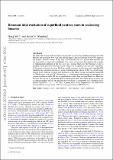| dc.contributor.author | Weinberg, Nevin N. | |
| dc.contributor.author | Yu, Hang,Ph. D.Massachusetts Institute of Technology. | |
| dc.date.accessioned | 2019-06-21T19:45:55Z | |
| dc.date.available | 2019-06-21T19:45:55Z | |
| dc.date.issued | 2016-10-05 | |
| dc.date.submitted | 2016-09 | |
| dc.identifier.issn | 0035-8711 | |
| dc.identifier.issn | 1365-2966 | |
| dc.identifier.uri | https://hdl.handle.net/1721.1/121384 | |
| dc.description.abstract | We study the resonant tidal excitation of g modes in coalescing superfluid neutron star (NS) binaries and investigate how such tidal driving impacts the gravitational-wave (GW) signal of the inspiral. Previous studies of this type treated the NS core as a normal fluid and thus did not account for its expected superfluidity. The source of buoyancy that supports the g modes is fundamentally different in the two cases: in a normal fluid core, the buoyancy is due to gradients in the proton-to-neutron fraction, whereas in a superfluid core it is due to gradients in the muon-to-electron fraction. The latter yields a stronger stratification and a superfluid NS therefore has a denser spectrum of g modes with frequencies above 10 Hz. As a result, many more g modes undergo resonant tidal excitation as the binary sweeps through the bandwidth of GW detectors such as LIGO. We find that similar or equal to 10 times more orbital energy is transferred into g-mode oscillations if the NS has a superfluid core rather than a normal fluid core. However, because this energy is transferred later in the inspiral when the orbital decay is faster, the accumulated phase error in the gravitational waveform is comparable for a superfluid and a normal fluid NS (similar to 10(-3)-10(-2) rad). A phase error of this magnitude is too small to be measured from a single event with the current generation of GW detectors. | en_US |
| dc.description.sponsorship | United States. National Aeronautics and Space Administration (Grant NNX14AB40G) | en_US |
| dc.language.iso | en | |
| dc.publisher | Oxford University Press (OUP) | en_US |
| dc.relation.isversionof | http://dx.doi.org/10.1093/mnras/stw2552 | en_US |
| dc.rights | Creative Commons Attribution-Noncommercial-Share Alike | en_US |
| dc.rights.uri | http://creativecommons.org/licenses/by-nc-sa/4.0/ | en_US |
| dc.source | arXiv | en_US |
| dc.title | Resonant tidal excitation of superfluid neutron stars in coalescing binaries | en_US |
| dc.type | Article | en_US |
| dc.identifier.citation | Yu Hang and Nevin N. Weinberg. "Resonant tidal excitation of superfluid neutron stars in coalescing binaries." Monthly Notices of the Royal Astronomical Society 464, 3 (October 2016): 2622–2637 | en_US |
| dc.contributor.department | Massachusetts Institute of Technology. Department of Physics | en_US |
| dc.contributor.department | MIT Kavli Institute for Astrophysics and Space Research | en_US |
| dc.contributor.department | LIGO (Observatory : Massachusetts Institute of Technology) | en_US |
| dc.relation.journal | Monthly Notices of the Royal Astronomical Society | en_US |
| dc.eprint.version | Author's final manuscript | en_US |
| dc.type.uri | http://purl.org/eprint/type/JournalArticle | en_US |
| eprint.status | http://purl.org/eprint/status/PeerReviewed | en_US |
| dc.date.updated | 2019-06-17T21:27:48Z | |
| dspace.date.submission | 2019-06-17T21:27:49Z | |
| mit.journal.volume | 464 | en_US |
| mit.journal.issue | 3 | en_US |
